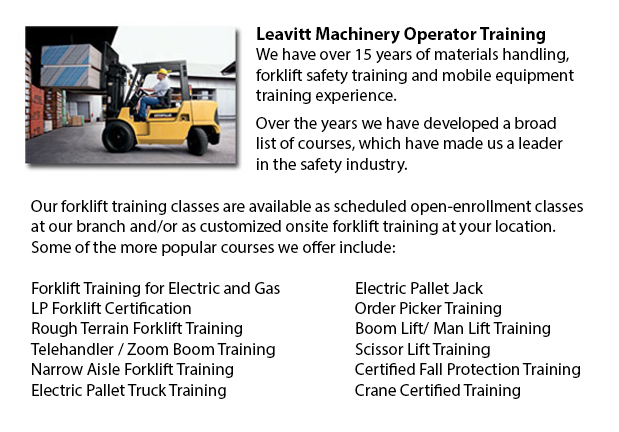
Barrie Forklift Training Schools - What Are Included In Our Forklift Training Schools
Are you searching for work as a forklift driver? Our regulatory-compliant mobile equipment operator training provides instruction in kinds of forklifts, pre-shift check, fuel types and handling of fuels, and safe use of a lift truck. Practical, hands-on training helps participants in obtaining fundamental operational skills. Course content comprises existing regulations governing the use of forklifts. Our proven forklift Schools are meant to provide training on these kinds of trucks: narrow isle forklift, counterbalanced forklift and powered pallet truck.
While the forklift is in operation, do not lower or raise the forks. Loads should not extend above the backrest. This is because of the possibility of the load sliding back towards the operator. Check for overhead obstructions and make certain there is adequate clearance before lifting a load. Stay away from overhead power lines. Once the load is raised straight up, tilt it back slightly.
While the load is raised the lift truck will be less steady. Make certain that no pedestrians cross underneath the elevated fork. The operator should never leave the lift truck while the load is raised.
The forks should be level when handling pallets, and high enough to extend all the way into and beneath the load. The fork's width must provide even distribution of weight.
Before unloading or loading the truck, chock the wheels and set the brakes. Floors need to be strong enough to support the weight of the load and the forklift combined. Fixed jacks could be installed in order to support a semi-trailer that is not attached to a tractor. The height of the entrance door must clear the forklift height by a minimum of 5 cm. Mark edges of ramps, docks or rail cars and avoid them.
-
Barrie Warehouse Forklift Safety Training
Barrie Warehouse Forklift Safety Training - Businesses normally face liability for injuries and damage sustained in workplace accidents. Warehouses can be hazardous places to the individuals who work there. That is the reason why employee safety is a... More -
Barrie Aerial Platform Training
Barrie Aerial Platform Training - Aerial lifts can accommodate many duties involving high and tricky reaching places. Normally used to carry out regular upkeep in buildings with high ceilings, prune tree branches, hoist heavy shelving units or mend p... More -
Barrie Forklift Ticket
Barrie Forklift Ticket - Pallet jacks and lift trucks are both intended for practically the same reason; to transfer goods from one location of your warehouse to another. This is basically where the comparison stops however. With the pallet jack, the... More -
Barrie Aerial Lift Training
Barrie Aerial Lift Training - An aerial work platform is a mechanized access platform. This machinery provides access to otherwise not accessible places for people or equipment. Also referred to as an aerial device or elevating work platform, the mac... More -
Barrie Aerial Boom Lift Training
Barrie Aerial Boom Lift Training - For people who operate or supervise the use of aerial lift platforms, correct aerial boom lift Training is required. The aerial lift platform is utilized for lifting individuals, tools and materials to elevated work... More -
Barrie Manlift Certification
Barrie Manlift Certification - The Elevated Platforms and Manlifts Certification program helps to provide the needed training on the work practices, safe operating procedures, rules and regulations regarding the everyday activities for the operators... More -
Barrie Overhead Crane Certification
Barrie Overhead Crane Certification - The overhead crane training certification course is designed to be effective with all participants regardless of literacy or language limitations. The course has two parts: a classroom training session and a prac... More -
Wheel and Track Loader Training in Barrie
Lift trucks are obtainable in several various units that have varying load capacities. The majority of typical lift trucks utilized in warehouse settings have load capacities of one to five tons. Bigger scale models are used for heavier loads, such a... More

Forklift Certification Barrie
TOLL FREE: 1-888-254-6157
Barrie, Ontario
forkliftcertificationbarrie.com
Email Us
About Us


